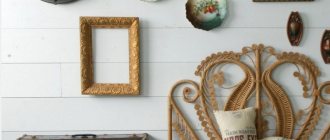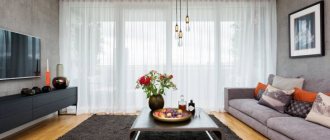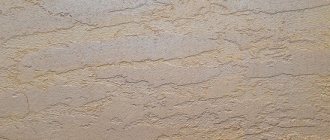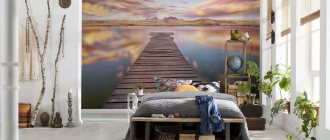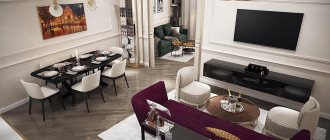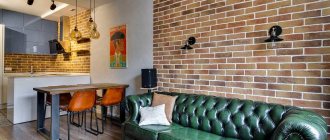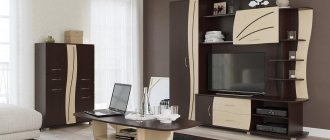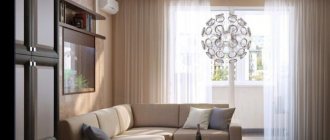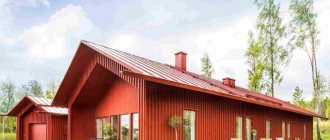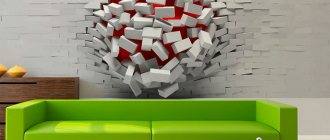There are many different moments in life that you want to remember every day. Bright and not very bright. Some brought joy and fun. Others made us who we are. Time passes, and details of the past fade from memory, and with them pleasant memories. We forget about our children's and teenage albums languishing on the top shelves of cabinets. They remain imprints of the emotions that we experienced in our early years. But what's stopping you from refreshing them? Do you live in an apartment? Hang photos from your old photo album on the wall of your living room or hallway. Are you the owner of a spacious country house? Then decorate the interior of your cottage with warm memories of long-gone moments in your family's life. Treat yourself to the warmth and comfort of home.
Any interior can be made cozy and original with the help of photographs on the wall.
Don't know where to start? Wondering how to decorate your wall with photos from your home photo album? We will tell you how to properly decorate the interior of your home with photographs. Interesting options lie in the simplest solutions, you just have to pay attention to them.
Photos of the interior of the room
Properly designed photos in decorative frames, or in a special way, can not only harmoniously fit into a certain interior style of the room, but also greatly improve its visual effects. Just like when arranging the interior decoration of a room, decorating with photographs has its own nuances and features.
A variety of photographs are suitable for wall decoration
Before you determine the format of the photo composition, as well as choose this or that style, you need to decide on the location of the photos. In this case, you need to be guided by some principles:
- The dynamism of the photo should correspond to the type of room. For example, wedding or dating photos of a married couple would be appropriate to place in the bedroom, but pictures of the whole family spending time on a picnic would be more successful to hang in the hallway of your home.
- Lighting plays a big role in the interior of a room with a photo wall. Light and sunny photographs should be placed on a well-lit side of the wall, while evening and more romantic ones can be placed in a dark corner of your apartment.
- The family tree and portraits of your ancestors are best placed in the hallway or on the wall of the staircase.
Favorite pictures on the wall in the kitchen dining area
In addition to those listed above, there are many more rules for arranging photographs with or without frames, taking into account the style of the interior, the color scheme of the room and lighting.
Floor panels for living room walls
A non-obvious, but very interesting solution is to install floor panels on the wall, be it vinyl or laminate . Good quality panels look natural, have a pleasant feel, varied texture and increased abrasion resistance. They stand out from other products at a very attractive price.
Large wooden panels with a light matte finish are suitable for wall decoration in the living room. If you use the same pattern of panels on one wall and on the floor, you will create an effect of interpenetrating planes, which will give the living room interesting depth.
Features of photo placement
As has already become clear, there are certain requirements for posting photographs. Let's try to figure it out in more detail.
Bright composition lifts your spirits
Important. Depending on the interior style of the room, the style of photographs and the choice of frames will vary greatly.
An interesting idea for decorating a watch with family photos
Manner is the dynamics, the mood of the person (people) captured in the photo. Also the clothes the character is wearing, his occupation, etc.
Classic
For a classic style in the interior, more strict photos of events are selected. People in such photos should be dressed in formal suits. The design of the wall in this case should also be in compliance with strict lines and shapes. Impressiveness and smoothness are inappropriate here. The colors of the frames can be different: white, black, gray and all shades of natural wood are suitable. The passe-partout is selected depending on the chosen frame.
Photos framed like paintings look good in a classic style.
Photos in gilded frames in a classic-style living room
Provence
Photos taken in nature, in fields or meadows, in the forest are suitable for French Provence. On the wall, such a composition is best placed within a dark shape, since Provence implies soft tones. This will create a clear accent. The photo collage can be diluted with various still lifes depicting fruits or flowers. In relation to Provence, blue-pink-violet lavender is perfect for decorating a wall with family photographs.
You can place a small mirror in the center of the composition
Favorite pictures framed in different sizes on the bedroom wall
A family tree can be successfully placed on a soft pink wall. This is done in the form of a pattern connecting the hung photographs. To give a special charm to the collage, it is decorated with additional decorative elements or, in our case, completed with drawings. These can be fluttering butterflies, birds, or simply lines depicted in bizarre convolutions and shapes.
Loft
The loft style is characterized by a rough interior and simplicity of finishing, or rather the lack thereof. On a wall made of red polished brick, a good option would be to arrange photo cards without frames on a stretched rope. The photo format should be in Polaroid style.
String and clothespins are perhaps the easiest way to effectively display photos.
In the lower or upper part of the wall (niche), you can make lighting with a soft white glow. This way your photos will look against the backdrop of the illuminated aura behind them.
Collage of photographs from different years on a brick wall in a bedroom
The order of the photo cards can be of any shape. The main feature is the relationship between the chosen style and the events reflected in the photo.
Photo wallpaper on the living room wall
Photo wallpaper is an interesting alternative to conventional wallpaper. Use them to decorate an entire wall with your favorite photo or graphic. In addition, you can use an extensive database of ready-made designs provided by the selected manufacturer.
The wall painting portfolio is currently based on exotic and animal motifs, large flowers, and all designs that use perspective fun, including shots of narrow streets, corridors or palace interiors. Because a wall mural resembles a huge painting and is a focal point, it looks best on an empty wall, such as behind a sofa.
Installing photo wallpaper on a wall in the living room is not a difficult task. It is enough to arrange the panels in the correct order and glue them to a previously cleaned, smoothed and primed surface. However, a lot depends on the type of material used. For the living room, latex photo wallpapers are most suitable, i.e. printed on latex paper (optionally bonded with laminate), and more expensive, but much more durable non-woven vinyl photo wallpapers.
Photo placement options
The most common option for arranging photos on the wall is to enclose each photo in a separate frame. But now there are a lot of exclusive and extraordinary ways of arranging family props to match the home interior.
Photos without frames on the wall of the stairwell
Symmetrical composition above the sofa in the living room
Random order
In this case, the photo is hung without frames. The mutual placement of such a collage can be of different shapes. It all depends on the event and the design of the surrounding interior. For example, a love story is shaped like a heart. But photo cards that remind you of the arrival of a small child in your family are placed on the wall with additional attributes in keeping with the theme of the event (decorative elements in the form of wooden patterns on the wall of various shapes).
Pictures without frames in the shape of a heart on the wall of a children's room
This composition can be changed at least every day
Mounting method
It can be as simple as using double-sided tape or a nail on a dowel. Or maybe an original combined one.
Why not use shelves to display photos?
Framed photographs do not need to be mounted on the wall, but simply placed on the floor.
Collage layout location
This is usually a straight wall. But besides an ordinary wall, it can be a corner of the room, decorated with photographs on both sides; a wardrobe that is part of the overall composition or completes the photo story with a large print on the entire door facade. Flowing background from floor to wall, or from wall to ceiling.
Beautiful and useful corner
A combination of different ways to frame photo cards
From the usual photo frame in the interior, with a mat around the perimeter, to designer carved wooden frames, decorated with precious materials. In modern styles, frames made of metal, glass and plastic have become very popular.
Use different frames and try different combinations
Contrast of large and small photos
This effect creates a certain charm that has a beneficial effect on a person’s worldview. At the same time, a large collage format should be made for portraits and close-up photos. Small photos complement the overall picture. In order not to overcrowd the wall with events, diluting images and details are used. This role is played by flower arrangements, wooden shelves matching the color of the interior, on which, along with candles and vases, your photos are installed.
It is convenient to look at photographs if the composition is located at eye level
Photos on the pendant
For hanging, make a large frame. A cork sheet is placed inside. A collage of small photographs is secured with stationery pins. If you additionally tighten the rope or fishing line, the photo is attached to clothespins (stationery, clothespins). This design is well suited to loft and minimalist styles.
Photos in frames, suspended on laces and pushpins
Photos in retro frames hanging on clothespins
Photos are attached to the wall in different ways. Attach the frame by twisting it thoroughly, and attach the photographs themselves to the frame without the risk of damaging them.
Types of wall decoration with paint
Due to the fact that decorative paint is too expensive, an alternative is in demand among construction professionals - artistic painting of walls with ordinary cheap paint. There are several varieties to create a unique room using ordinary paints. Let's take a closer look at them.
Stippling
This is the name for painting walls with decorative paint, which creates the effect of an old, shabby surface. To create such a masterpiece you need:
- Cover the surface with the chosen color.
- Apply acrylic paint to create a contrasting shade.
- Apply colored glaze to the surface in combination with the shade of the painted wall, smooth it evenly over the surface with a wide brush, and when all surfaces are covered with glaze, touch the uncured paint with the same brush.
- A round paint brush should be poked in a chaotic manner over the surface, thus making the walls look antique.
There is only one drawback to this method of application: all irregularities and bulges become more noticeable.
Skin effect
This decorative coloring is a great idea for decorating an office; it gives the impression that the walls are covered in leather. After preparing the surface, you need to start finishing:
- We cover the walls with latex paint of our favorite color.
- Making a suede tassel.
- Mix the glaze with latex paint, slightly darker than the tone of the surface.
- We cover a piece of the surface with the mixture, moisten a suede brush in water and squeeze it out, lightly touch it over the not-dried coating, making streaks and partially removing it.
- We blot the existing noticeable lines with a piece of wet suede to give a natural leather finish.
Venetian plaster effect
One of the most beautiful and decorative ways to paint walls. To recreate the Venetian effect, you must complete the following steps:
- Place latex paint in a wide container. Sprinkle a little pigment for paint on one side, carefully stir half with a stick so that the dark and light sides come out in the container.
- We take a lighter paint on a spatula and apply it to the coating like regular plaster.
- Dip a spatula in a dark color and cover a piece of the wall.
- When light and dark spots appear on the wall, we begin to move the spatula along the wall in different directions to evenly smear the colors for a harmonious look.
At the finishing stage, Venetian plaster is sanded with fine sandpaper and rubbed with a special wax composition.
To create the “Venetian plaster” effect, you must use only a plastic spatula during the work process.
Wrinkled skin effect
This effect is easy to create, but requires patience, because everything is done slowly, gradually.
- Take a piece of paper and paint a piece of the wall according to its size.
- We crumple the sheet, apply it to the surface, begin to smooth it, while creating the outline of a crumpled coating.
The entire wall is gradually processed in small pieces.
In the video: the effect of wrinkled (worn) leather on the wall.
Painting with a rag roller
For decorative painting of walls, you can use not only purchased tools, but also improvised means. A simple rag roller creates an interesting indoor effect that is suitable for children's rooms. If this method is used, the surface preparation may not be ideal, because this type of finish hides all imperfections on the wall.
Roller painting steps:
- Apply the first layer of paint and wait for it to dry.
- Dilute another shade of the base color (slightly darker than the previous one).
- We soak a rag in paint, twist it to make a tourniquet, and wrap it around the roller.
- We paint from the very top of the wall to the bottom in different directions to obtain a textured pattern.
Photo frames
When arranging a collage with ordinary frames, you need to additionally use a passe-partout. This is ordinary colored cardboard with no middle part. The photograph is placed in it.
Black frames convey rigor and graphics, white frames convey sophistication and grace.
In addition, the use of picture frames is interesting. In this case, the photos get a volumetric effect. This is achieved by the absence of borders around the perimeter, that is, the image flows onto the wall. This frame format is often used for composite photographs, the image of which is divided into several frames.
The wooden frame and the photograph hang separately, but form an overall composition
The most remarkable and memorable wall designs are created thanks to the people in the frame, and a little due to the skill of the photographer. Seasoning such collages with decorative elements, hand-carved patterns, and painted walls are the main components of a successful solution. Accents are appropriate here. Decorative clocks, in harmony with a cascade of photographs, wooden shelves with flower vases, and other unusual items of interior decoration of your apartment - all this can be very successfully played with material from your family album.
Live life to the fullest, create moments by capturing them on camera film; and then, on one of the warm winter evenings, remember those moments of happiness experienced together with your family over a cup of hot chocolate. Create with us!
When decorating a wall, you can “go outside the box”
Plaster on the wall in the living room
Plaster, unlike lining, is purely decorative. It divides the wall surface into smaller segments and diversifies its appearance. When used correctly, it can improve the proportions of the living room, optically raise the ceiling in a low room or lower it if the interior is very high. Elegant plaster is a hallmark of the French style, but it works equally well in modern interiors (creating an interesting contrast with modern decor), glamour, eclectic or New York style.
Living room wall plaster can be made from wood or plaster lamellas that simply adhere to the decorated surface. The planks should create a symmetrical, well-thought-out composition (consisting of rectangles and squares). Plaster will look better if it is painted the same color as the wall.
Repeating pictures
One of the popular trends of recent years in wall decor is decorating walls using textured rollers with a wide variety of patterns. This method allows you to easily and quickly turn your walls into real painted pictures, which look very much like wallpaper, but are not wallpaper at all.
All that is needed in this case is to again apply a background shade, and then dip a specially selected roller into the paint and run it over the entire surface of the walls, moving from top to bottom. This way, you'll end up with long stripes of repeating patterns that come together to create one vibrant canvas.
Of course, all these methods have many more nuances associated with the correct selection of the necessary paints, preliminary preparation of the walls and much more. Therefore, before you start making repairs, you must first choose the painting technique that interests you most, and then find out in detail the details of its implementation.
Here, for example, is one of the master classes on how to properly paint walls using a textured roller:
Have you already tried painting the walls at home yourself? And if so, what exactly did you apply and in what way?
Share
